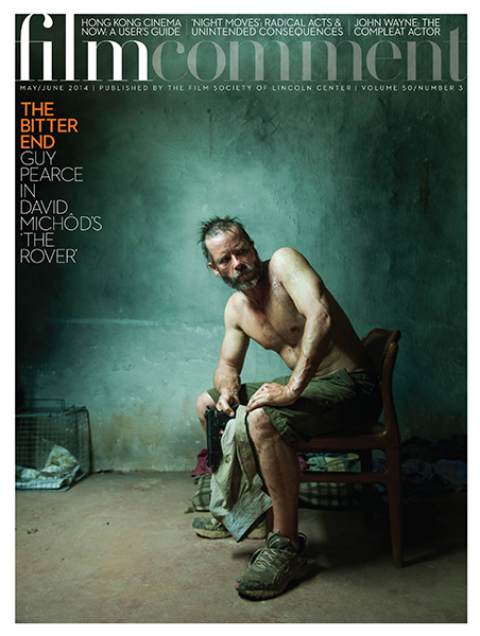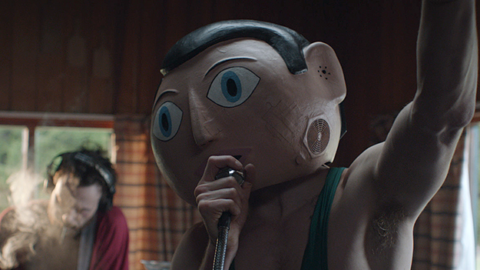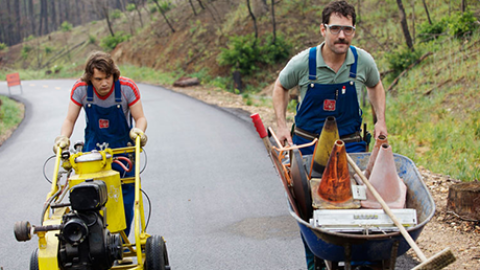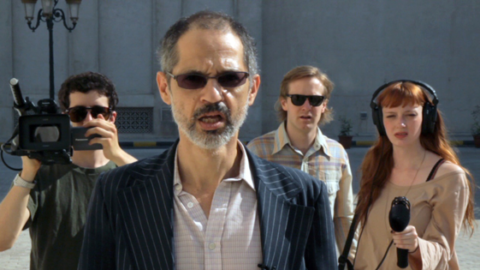As I ended up telling many of the kind, outgoing people I met while waiting in lines or inside theaters, this wasn’t my first rodeo—I last attended SXSW in 2006. It’s an established fact that the corporate branding presence at the festival has become brazen and pervasive in the intervening years (e.g., Bartle Bogle Hegarty Labs using homeless people as WiFi hotspots during the 2012 edition), but some of this year’s programming, particularly Edward Snowden’s live-streamed interview from Russia, had an activist/hacktivist bent that flew in the face of the surrounding Times Squarification.

The Internet’s Own Boy
Having to fight past the crowd around the Subway Flatizza brainwave booth to make a screening of The Internet’s Own Boy: The Story of Aaron Swartz puts a finer point on that schizophrenia. Brian Knappenberger’s documentary argues that the suicide of the man who helped spearhead anti-SOPA protests was the result of aggressive government lawyering in service of private-sector interests. It’s safe to say, without hyperbole, that the Internet wouldn’t be what it is today without Swartz’s contributions to the development of RSS (which was instrumental in the rise of blogging), Creative Commons licensing, or the social news site Reddit. Moreover, the fact that he won’t be able to finish his work in increasing the transparency of online legal and academic resources is detrimental to all. Knappenberger attempts to balance a portrait of a young man who was prodigious, stubborn, and deeply principled with an examination of the far-reaching issues his work raised. But the hasty turnaround (Swartz died in January 2013) and certain mildly unethical interactions (badgering Swartz’s ex-girlfriend over things she said to prosecutors that strengthened their case against him; lingering on his sobbing mother as she says she couldn’t go on being filmed) do the film a disservice.
Concluding with a call to repeal the Computer Fraud and Abuse Act and to visit the organizations Swartz founded or were set up in his honor, The Internet’s Own Boy doesn’t offer up any answer to a scary question: is civil disobedience even possible in an age in which corporations own everything and have enough money and lobbying power to set the rules? Yet as documentaries like Diana Whitten’s Vessel or Diego Luna’s star-studded biopic of Cesar Chavez make clear, successful activism is in large part a process of trial and error. The first Hollywood biopic of a Latino who wasn’t a musician, Cesar Chavez does occasionally lapse into the civil-rights-film clichés of evil old white guys, whose de facto leader is played with sneering aplomb by John Malkovich. It also downplays certain historical facts in order to ensure that the audience can readily relate to Cesar (Michael Peña)—such is the price of imposing a three-act structure onto real life. Thankfully, fine performances, smart dialogue, and fast pacing prevent Luna’s film from descending into schmaltz. (My reaction may have been skewed by seeing it in a theater packed with United Farm Workers members and their families, who cried and sang along with the film, and by watching the real Dolores Huerta lead the audience in several chants after the screening.) Vessel, a documentary about the evolution of Women on Waves, an organization that provides information about abortion in countries where it is illegal, earns kudos for not centering the film on its founder, Dr. Rebecca Gomperts. Though viewers conditioned by POV syndrome to require a central character will feel it lacks cohesiveness, the emphasis in Whitten’s film on facts (every 10 minutes a woman dies due to an illegal abortion) and the collaborative nature of WOW’s work, which relies on a network of thousands of women around the world, is both inspirational and instructional. This is how you start a revolution, warts and all.

Vessel
The narrative fiction films were significantly less satisfying however. Over and over, the same tired visual aesthetics—endless two shots, extreme close-ups, identical color palettes, soft focus, and bokeh effects—were competently deployed for pithy tales of New Yorkers on capers (Wild Canaries, Fort Tilden, Before I Disappear), coming-of-age stories that lacked emotional veracity (Premature, I Believe in Unicorns), or ill-conceived efforts that made it to the screen only thanks to their star-studded casts. A prime offender in the last category, Jen McGowan’s Kelly & Cal boasts Juliette Lewis as Kelly, a former riot grrl who’s now a bored housewife; Cybill Shepherd as her meddling mother-in-law; and Jonny Weston as Cal, the casual, beer-drinkin’, wheelchair-bound teen next door who helps Kelly get her punk back. Aside from the clunky cripple jokes, clumsy editing that clearly attempts to compensate for bad takes, and puerile verbal sparring that immediately segues into hollow epiphanies, the titular duo’s unlikely friendship drifts into facile male wish-fulfillment territory, with the older Kelly leading her young neighbor on, at one point appearing fully naked at a window for his benefit (he ends up re-creating the moment as a life-size sculpture for a disabled-artists exhibition). The fact that Kelly & Cal was written and directed by two women serves as another reminder that there are still those who won’t hesitate to degrade their own gender if they think they can make a buck off it.
Outside of bigger films that had made the festival rounds—Richard Linklater’s rousing Boyhood, David Gordon Green’s compellingly nasty Joe, Lenny Abrahamson’s offbeat yet thoughtful Frank, and what might be Alejandro Jodorowsky’s best film, The Dance of Reality—I saw nothing that eschewed the aforementioned formal clichés, save for the work of two first-time directors, Paul Wright and John Magary. In Wright’s For Those in Peril, the tale of Aaron (George MacKay), the lone survivor of a Scottish fishing vessel lost at sea, unfolds across a mélange of formats (from Super 8 and lo-fi camcorder to glossy digital and miscellaneous found footage) and feels like a Malick-influenced nightmare. The film’s audaciously fantastical final scene completely upends the naturalistic miserablism that precedes it, and forces a wholesale reconsideration of the story. You might understand this ending as an eruption of magical realism, or simply laugh your ass off. Though this doesn’t sound like a ringing endorsement, For Those in Peril is a strong first film—but still very much a first attempt.

The Mend
My favorite narrative discovery of the festival, unequivocally, was The Mend, which alternates between the restlessness and acutely observed masculine behavior of Cassavetes’ Husbands and the wit and energy of a Cukor comedy. Mat (Josh Lucas) spontaneously decides to set up shop in the apartment of his (seemingly) responsible brother Alan (Stephen Plunkett) while the latter is away on a romantic vacation with his live-in girlfriend, Farrah (Mickey Sumner). When Alan returns home early without her, offering no explanation, Mat decides to stay on—along with his on-again, off-again girlfriend, Andrea (Lucy Owen), and her son. The Mend contains some trenchant observations about siblings, relationships, and dysfunctional families, and Magary makes unconventional yet never confusing decisions in terms of editing and camera position, demonstrating an engagement with the medium that doesn’t detract from the story. Magary’s is the type of sensibility that SXSW should be seeking out—low-budge but meaty, visually inventive, and, most importantly, not rehashing conceits you could’ve seen here in 2006, albeit shot with an inferior camera.








